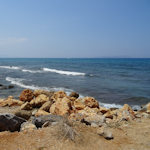
Photos of life in refugee camps in Greece offer a window into the gap between how EU countries likes to think of themselves and the reality. The Weltmuseum brings home that message in the Now you see me Moria exhibition.
- 20 photos taken by the refugees themselves
- Original captions provided by the same source
- Asks uncomfortable questions of the affluent observer
- Runs May 3, 2021 – Mar 31, 2022
- See also:
- Photography exhibitions in Vienna
An inside view

(Photo © KHM-Museumsverband)
The word Moria carries a certain negative resonance when you know your Tolkien. A dark place of little comfort and not somewhere the Fellowship of the Ring were keen to hang around in.
Some might see a parallel to the refugee camp of the same name that burned down in 2020: one of various refugee camps in the Aegean.
Unlike Tolkien’s heroes, the inhabitants of Moria and its equivalents elsewhere had and have no easy way out of their plight. The Now You See Me Moria project came into being to throw light on that situation.
Initiated by an Afghan refugee and a Dutch photo editor, the project seeks to document camp life through photos and reports. No easy task given limits on media access and a ban on photography for NGO workers.
The collated photos come from the refugees themselves and a selection appear in the Weltmuseum’s response to the project’s appeal for greater visibility. The Now you see me Moria exhibition features around 20 photos, together with captions (in English and German) also provided by the refugees.
Given the provenance of the displays, the whole exhibition exudes a rare authenticity. The photos reveal locations that look like something we normally associate with war-torn states in other continents and not a holiday island in the EU.
So you find water-filled alleyways between temporary dwellings, long queues for water, fences topped with barbed wire, and a collection of tea mugs you won’t see featured in any store catalogues.
The surrounding bright, white, Renaissance-like ambience of the Weltmuseum’s atrium contrasts markedly with the largely desolate views and monotonous banality of camp life shown in the images. While you sup your coffee, a refugee brews tea on a self-made fire.
The refugees’ own words certainly belie the image that some want us to have of these people as purely economic migrants looking to scrounge off Europe.
The texts identify the authors as people simply searching for clarity and a chance. The words express their perplexity and pose the kind of questions we don’t want to answer for fear of exposing our own complicity in their fate: the yawning gap between sentiment and action.
Now You See Me Moria invites us to put ourselves in the position of the refugees and implicitly asks if we would accept those same conditions for so long. The tone is not resentful or aggressive, but questioning, even tinged with optimism. The exhibition simply highlights the failure of the system and the clipping of human potential. As one caption notes:
We came with our wings, but unfortunately, we do not have a sky to fly.
Tickets & dates
View the photos from May 3rd, 2021 to March 31st, 2022. A ticket for the Weltmuseum includes access to the exhibition.
Concurrent temporary exhibitions in the building for much of the same time include Dark Pairing (a series of images of plants interwoven with yarn as an invitation to explore aspects of colonialism) and I saw more than I can tell (portrait photos of North American indigenous peoples in traditional dance clothing).
How to get to the exhibition
Follow the tips for the Weltmuseum itself. The photos occupy three sides of the main atrium immediately after you pass the ticket counter.
Address: Heldenplatz, 1010 Vienna